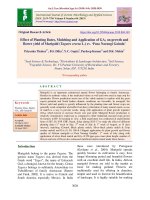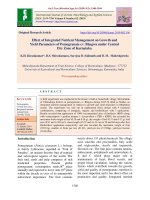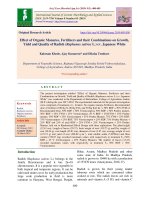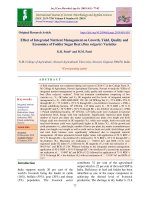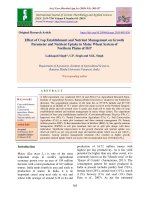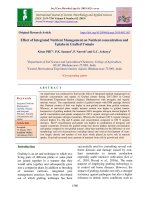Effect of integrated nutrient management on growth characters of radish (Raphanus sativus L.) cv. Pusa Chetki
Bạn đang xem bản rút gọn của tài liệu. Xem và tải ngay bản đầy đủ của tài liệu tại đây (154.05 KB, 5 trang )
Int.J.Curr.Microbiol.App.Sci (2018) 7(11): 467-471
International Journal of Current Microbiology and Applied Sciences
ISSN: 2319-7706 Volume 7 Number 11 (2018)
Journal homepage:
Original Research Article
/>
Effect of Integrated Nutrient Management on Growth Characters of Radish
(Raphanus sativus L.) cv. Pusa Chetki
P. Jaisankar*
Department of Horticulture, Faculty of Agriculture, Annamalai University,
Annamalai nagar-608 002, Tamilnadu, India
*Corresponding author
ABSTRACT
Keywords
Radish, Organic
manure, Biofertilizer, Growth
Article Info
Accepted:
07 October 2018
Available Online:
10 November 2018
A field experiment was conducted in 2014 at farmer’s field in Varagoorpettai village,
Cuddalore, Tamilnadu to study the effect of integrated nutrient management on growth
characters of radish (Raphanus sativus L.) cv. pusa chetki. The experiment was laid out in
Randomized Block Design with three replications and ten treatments. The treatment
combination consisted of an organic manures (FYM and Vermicompost) Bio-fertilizer
(Azospirillum) and Plant bio regulator (Humic acid). The treatment details viz., T1 - FYM
@ 17.5 t ha-1+ Azospirillum @ 5 kg ha-1 + Humic acid @ 0.1 % ha-1, T2 - FYM @ 17.5 t
ha-1+ Azospirillum @ 5 kg ha-1 + Humic acid @ 0.2 % ha-1, T3 - FYM @ 25 t ha-1 +
Azospirillum @ 5 kg ha-1 + Humic acid @ 0.1 % ha-1, T4 - FYM @ 25 t ha-1+ Azospirillum
@ 5 kg ha-1 + Humic acid @ 0.2 % ha-1, T5 - Vermicompost 10 t ha-1 + Azospirillum @ 5
kg ha-1 + Humic acid @ 0.1 % ha-1, T6 - Vermicompost 10 t ha-1 + Azospirillum @ 5 kg
ha-1 + Humic acid @ 0.2 % ha-1, T7 -Vermicompost 12.5 t ha-1 + Azospirillum @ 5 kg ha-1
+ Humic acid @ 0.1 % ha-1, T8 -Vermicompost 12.5 t ha-1 + Azospirillum @ 5 kg ha-1 +
Humic acid @ 0.2 %, T9 – Recommended dose of NPK @ 80:40: 80 kg ha-1 and T10 Absolute Control. Among the treatment significantly influenced on application of
Vermicompost 12.5 t ha-1 + Azospirillum @ 5 kg ha-1 + Humic acid @ 0.2 % ha-1 (T8)
resulted in maximum values of growth attributes viz., days taken for germination (3.12),
shoot length (43.56 cm), number of leaves per plant (14.68 DAS), leaf area (185.86), shoot
weight (56.23 g), crop dry matter production (26.13 g). Application of Vermicompost 12.5
t ha-1 + Azospirillum @ 5 kg ha-1 + Humic acid @ 0.2 % ha-1 is recommended to get higher
growth in radish.
Introduction
Radish (Raphanus sativus L.) is one of the
most important root crops belonging to the
family Cruciferae. It is grown both in tropical
and temperate regions of the world and is
probably a native of Europe and Asia. Radish
is grown for its edible young, tender and
fusiform roots which are eaten raw as a salad
or cooked as a vegetable. It is a good source of
minerals, vitamins A and C and medicinal
properties. Organic agriculture is gaining
movement in India due to the individual as
well as group efforts to conserve environments
and avoid contamination of the farm produce
from the use of chemical fertilizers and
467
Int.J.Curr.Microbiol.App.Sci (2018) 7(11): 467-471
pesticides. The important tenet of the organic
food movement is that promotes ecological
soundness and sustainable use of natural
resource, also maintenance of crop diversity.
Farmyard manure being a bulky organic
material releases the soil compaction and
improves the aeration in addition to the supply
of essential plant nutrients and organic matter,
thereby increasing the soil microbial
establishment along with the accumulation of
excess humus content. Vermicompost
provides vital macronutrients (N, P2O5, K2O,
Ca and Mg) and micronutrient Fe, Mn, Zn and
Cu). The chemical analysis of Vermicompost
reveals that the N, P2O5, K2O, content was 0.8,
1.1, 0.5, respectively (Giraddi et al., 1993).
Humic acid influence the plant growth by
modifying the physiology of plants and
improving the physical, chemical and
biological properties of soil. Humic acid is
reported to increase the permeability of plant
membranes, resulting in higher metabolic
activity.
Biofertilizer or microbial inoculants are ecofriendly, non-bulky, cheap and renewable
sources of nutrients for plants. The application
of bio-fertilizers also helps in improving
biological activities of soil. Nitrogen-fixing
bacteria belonging to genus Azospirillum is
known to increase the yield by 5 to 20 percent
with a saving of nitrogen up to 40 percent of
the recommended dose (Dart, 1986).
Azospirillum not only fixes biological
nitrogen but also produces a growth regulator
like
substance
(Sundaravelu
and
muthukrishnan, 1993). The integrated nutrient
management system approach utilizes a
judicious combination of inorganic fertilizers
and organic manures in building soil fertility
and to increase the production potential of any
crop (Khalid et al., 2015). Moreover, this
approach is economically cheap, technically
sound, practically feasible and is capable of
maintaining the sustainability in production.
Therefore, integrated nutrient management
practice is the only answer for the production
of good quality of tuber yield. Keeping in
view the above facts in mind, the present
studies have been planned to use organic,
inorganic and biofertilizers on growth and
yield contributing characters of radish.
Materials and Methods
The study was conducted during 2015 at
farmer field in Varagoorpettai village,
Cuddalore, Tamilnadu (110 24’ N latitude,
75°11' E longitude and + 5.70 m MSL above
mean sea level). The soil was sandy loam in
texture, alkaline in reaction (pH 5.74) low in
available nitrogen (192.7 kg ha-1), medium in
available phosphorus (18.5 kg P2O5 ha-1) and
higher in available potassium (299.0 kg K2O
ha-1). Thus ten treatments were laid out in
Randomized Block Design with three
replications. The treatment combination
consisted of an organic manures (FYM and
Vermicompost) Bio-fertilizer (Azospirillum)
and Plant bio regulator (Humic acid),
Recommended dose of NPK (80: 40: 80) and
along with control. Treatment details viz., T1 FYM @ 17.5 t ha-1+ Azospirillum @ 5 kg ha-1
+ Humic acid @ 0.1 % ha-1, T2 - FYM @ 17.5
t ha-1+ Azospirillum @ 5 kg ha-1 + Humic acid
@ 0.2 % ha-1, T3 - FYM @ 25 t ha-1 +
Azospirillum @ 5 kg ha-1 + Humic acid @ 0.1
% ha-1, T4 - FYM @ 25 t ha-1+ Azospirillum
@ 5 kg ha-1 + Humic acid @ 0.2 % ha-1, T5 Vermicompost 10 t ha-1 + Azospirillum @ 5
kg ha-1 + Humic acid @ 0.1 % ha-1, T6 Vermicompost 10 t ha-1 + Azospirillum @ 5
kg ha-1 + Humic acid @ 0.2 % ha-1, T7 Vermicompost 12.5 t ha-1 + Azospirillum @ 5
kg ha-1 + Humic acid @ 0.1 % ha-1, T8 Vermicompost 12.5 t ha-1 + Azospirillum @ 5
kg ha-1 + Humic acid @ 0.2 %, T9 –
Recommended dose of NPK @ 80:40: 80 kg
ha-1 and T10 - Absolute Control. The Radish
(cv. Pusa Chetki) seeds were sown during
mid-December in 1m x 2 m plot size. The
468
Int.J.Curr.Microbiol.App.Sci (2018) 7(11): 467-471
experiment field was supplied with well rotten
farmyard manure (20 t ha-1). The observations
were recorded on five randomly selected
plants from each plot on different growth
characters like days taken for germination,
number of leaves per plant (DAS), leaf area,
crop dry matter production (g) (Table 1).
The data was analysed by adopting the
standard procedure of Panse and Sukhatme
(1985) and using AGRISTAT software.
Wherever, the results were found significant,
critical differences (CD) were computed at 5
percent level of probability to draw statistical
conclusions.
Results and Discussion
Growth characters
The results of the present investigation
showed that there was a significant difference
on the growth parameters, viz., days taken for
germination, shoot length, number of leaves,
leaf area, shoot weight and crop dry matter
production (Table 1).
Table.1 Effect of integrated nutrient management and growth characters of
Radish cv. Pusa Chetki
S.
No.
Treatment description
T1
tonnes ha-1 +
Azospirillum@5 kg ha-1 + Humic acid
@ 0.1% ha-1
tonnes ha-1 +
Azospirillum@5 kg ha-1 + Humic acid
@ 0.2% ha-1
FYM@25 tonnes ha-1 +
Azospirillum@5 kg ha-1 + Humic acid
@ 0.1% ha-1
FYM@25 tonnes ha-1 +
Azospirillum@5 kg ha-1 + Humic acid
@ 0.2% ha-1
Vermicompost 10 tonnes ha-1 +
Azospilillum @ 5 kg ha-1 + Humic acid
@ 0.1 % ha-1
Vermicompost 10 tonnes ha-1 +
Azospilillum @ 5 kg ha-1 + Humic acid
@ 0.2 % ha-1
Vermicompost 12.5 tonnes ha-1 +
Azospilillum @ 5 kg ha-1 + Humic acid
@ 0.1 % ha-1
Vermicompost 12.5 tonnes ha-1 +
Azospilillum @ 5 kg ha-1 + Humic acid
@ 0.2 % ha-1
Recommended dose of NPK @
80:40:80 kg ha-1
Absolute Control
S.Ed
C.D (p=0.05
T2
T3
T4
T5
T6
T7
T8
T9
T10
Number of
days taken for
germination
4.87
Shoot
length
(cm)
35.71
Number
of
leaves
11.27
Leaf
area
(cm2)
136.21
Shoot
weight (g
plant-1)
47.36
Crop dry matter
production (g
plant-1)
23.64
4.40
38.47
12.24
14.03
52.65
24.73
3.88
40.44
12.68
165.12
53.27
24.93
4.86
35.73
11.52
136.18
47.30
23.64
4.84
35.45
11.72
138.28
47.27
23.63
5.56
34.78
10.26
131.16
42.6
22.62
3.48
41.74
13.51
175.35
54.58
25.58
3.12
43.56
14.68
185.86
56.23
26.13
3.94
40.53
12.65
165.92
53.21
24.92
6.20
0.10
0.21
28.44
0.19
0.38
9.52
0.18
0.38
125.04
2.18
4.59
39.60
0.14
0.29
21.85
0.09
0.21
469
Int.J.Curr.Microbiol.App.Sci (2018) 7(11): 467-471
The days taken for germination (3.12 DAS)
was found to be early in the treatment which
received Vermicompost 12.5 tonnes ha-1 +
Azospirillum @ 5 kg ha-1 + Humic acid @ 0.2
% ha-1 (T7) + whereas the days taken for
germination was delayed in control.
Vermicompost resulting from degradation of
organic waste which is rich in nutrient content
and growth promoting substances may fit well
in integrated nutrient management for crop
germination. This was in line with the result
of Kamalakar Reddy and Venkata Rao
(2004). The shoot length (43.56 cm and 45
DAS) was found to be increased significantly
due to the application of Vermicompost 12.5
tonnes ha-1 + Azospirillum @ 5 kg ha-1 +
Humic acid @ 0.2 % ha-1 (T8) was recorded to
be the highest when compared to other
treatments. Application of 50 percent RDF of
NPK plus vermicompost at the rate of 2 t ha-1
plus Azospirillum and phosphobacteira
increased the vine length, earliness in
flowering and yield in cucumber (Prabu et al.,
2010). The number of leaves per plant and
leaf area showed significant variations in the
crop. The results of the investigation revealed
that application of Vermicompost 12.5 tonnes
ha-1 + Azospirillum @ 5 kg ha-1 + Humic acid
@ 0.2 % ha-1 (T8) increased the number of
leaves (14.68 and 45 DAS) and leaf area
(185.86 cm2) when compared to (T10). The
increase in a number of leaves may be due to
the vital macro and micronutrient availability
with vermicompost. This was on the line with
the result (Giraddi, 1993). Increasing trend in
the shoot weight and dry matter production
were recorded in the present investigation.
line with the reports of Rajamanickam et al.,
(2008) who revealed enhanced growth
parameter in plants grown in the potting
mixture, treated with vermicompost.
In the present investigation, supplementation
of radish with organic fertilizers along with
bio-fertilizer and plant bio regulator resulted
in higher growth parameters. Therefore, to
produce a sustainable higher growth of radish
it is recommended to make use of
Vermicompost
12.5
tonnes
ha-1
+
-1
Azospirillum @ 5 kg ha + Humic acid @ 0.2
% ha-1 (T8) to enhance growth in addition to
improve soil fertility in radish cultivation.
References
Dart, P.J. 1986. Nitrogen fixation associated
with non-legumes in agriculture Plant
and Soil. 90: 303-334.
Giraddi, 1993. Vermiculture and role in
agriculture. In: Proc. Course on the
officers of the state Department of
Agriculture, Karnataka, 18-20 October
by the Department of Agriculture
Microbiology, University of Agriculture
Sciences, Dharwad, pp. 50-54.
Kamalakar Reddy, P. and P. Venkata Rao.,
2004. Growth and yield of bitter gourd
(Momordica charantia L.) as influenced
by
vermicompost
and
nitrogen
management
practices.
J.
Res.
ANGRAU, 32(3): 15-20.
Khalid M., Yadav B.K., Yadav M.P. 2005.
Studies on the effect of integrated
nutrient management on growth and
yield attributes of radish (Raphanus
sativus L.). Ann. Hort., 8(1):81-83.
Panse, V.G. and P.V. Sukhtme. 1985.
Statistical Methods for Agricultural
Workers. ICAR, New Delhi, Pp. 145155.
Prabhu, M., A. Ramesh Kumar and K.
Rajamani. 2010. Influence of different
organic substances on growth and
The application of Vermicompost 12.5 tonnes
ha-1 + Azospirillum @ 5 kg ha-1 + Humic acid
@ 0.2 % ha-1 envisaged maximum shoot
weight (56.23 g plant -1) and dry matter
production (26.13 g plant-1) in T8 whereas it
was recorded to be minimum in T10 (Control).
Enhancement in the growth attributes due to
Vermicompost in the present research is in
470
Int.J.Curr.Microbiol.App.Sci (2018) 7(11): 467-471
herbage yield on Sacred basil (Ocimum
sanctum) Indian J. Agri. Res., 44(1): 4852.
Rajamanickam, C., Balasubramanian, S. and
S. Natarajan, 2008. Studies on nursery
management in papaya (Carica papaya
L.) cv. Co2, proceedings of second
international symposium on papaya,
pp.74.
Sundaravelu, S. and T. Muthukrishnan, 1993.
Effect of seed treatment with
Azospirillum and gibberellic acid on the
growth and yield of radish (Raphanus
sativus L. var. Japanese white). South
Indian Hort., 41(4): 212-213.
How to cite this article:
Jaisankar, P. 2018. Effect of Integrated Nutrient Management on Growth Characters of Radish
(Raphanus sativus L.) cv. Pusa Chetki. Int.J.Curr.Microbiol.App.Sci. 7(11): 467-471.
doi: />
471
